How Much Is the Hudson River Park Worth to You?
Community Board 1 held a joint meeting of its Tribeca and Waterfront committees last night in order to hear the Friends of Hudson River Park’s proposal for a Neighborhood Improvement District. What that means: If you live or own a business west of Hudson Street, you could end up paying what is essentially a tax.
The park needs money because the Hudson River Park Act, which established the park, dictated that the park must be self-sustaining; unlike most other parks, it receives no state or city support for maintenance and operations. Until now, the revenue from the commercial aspects of the park (such as Pier 40 parking) has been enough, but the park has begun drawing on reserves. The view ten years out is that the park will have an annual need of around $11 million (more) dollars.
Another wrinkle: The Hudson River Park act prohibits the Hudson River Park Trust from spending money outside the park, which wouldn’t necessarily be a huge issue except the state has handed over the Route 9A medians to the city, but the city hasn’t accepted them, so they’re entering a state of disrepair. Traditionally, we were told at the meeting, because the medians (and the plantings therein) fall beyond what the city normally deals with, they get passed along to an organization such as Friends of Hudson River Park.
So how much would you have to pay? It depends on the size of your apartment (if you own—and again, this is only for those who live between the west side of Hudson Street and the Hudson River), because it’s 7.5¢ per square foot. The Friends of Hudson River Park seems to think that landlords won’t pass along the assessment to their tenants but will for commercial tenants.
The park’s waterfront location makes it somewhat fragile, so maintenance is likely to absorb much of the funds that are raised. One member—and I’m including it here because I strongly agree—feared that the influx of funds would lead to “mission creep” versus staying focused on the park. Indeed, the Friends say that beyond maintenance and operations, they’ll use the Neighborhood Improvement District revenue for “neighborhood needs”—projects like pedestrian bridges and crossing guards (sigh), street furniture (really?), signage to/from the park (no one has ever asked me how to find the park, and I get asked directions daily), as well as “promotion of the park and businesses.” Helping nearby “Friends of” groups—such as Friends of Bogardus Garden—was also discussed as a possibility.
This is the outreach phase, with public meetings to come in the fall and winter; the Friends of Hudson River Park needs to demonstrate that at least 50% of those being assessed support the plan.
The park has utterly changed this neighborhood and many others, and a Neighborhood Improvement District strikes me as a logical way to address many of the park’s financial issues, especially (a) given the relative wealth of the west side, and (b) the park’s number of visitors is likely to increase from an already impressive 17 million annually once the city’s bikeshare programs starts July 31.
My only other quibble, then, is why stop at Hudson? Take it to W. Broadway, at least. And why stop at Chambers? The folks on Warren and Murray use the park as much as anyone.
Herewith, a bunch of slides from the presentation. Click them to read the text (I added the text in read, in case that’s not obvious):








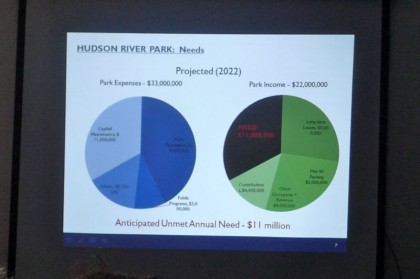
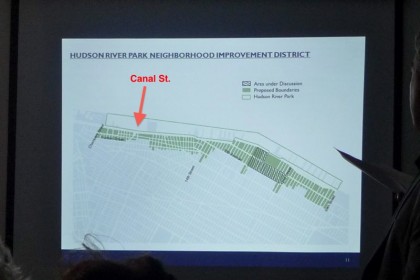
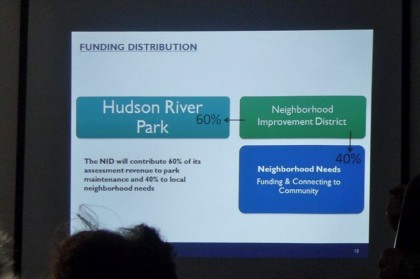
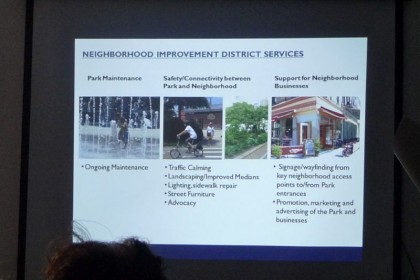
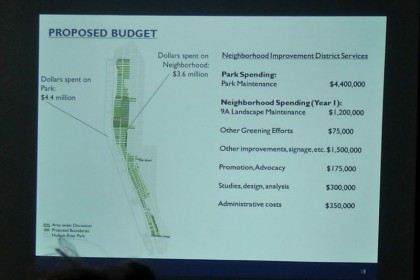
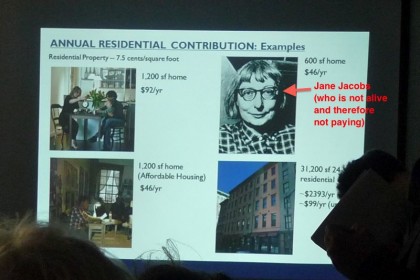
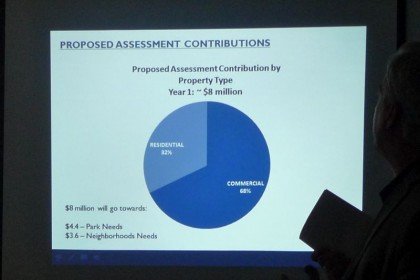







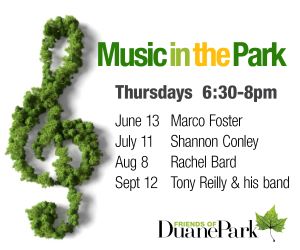
About extending the boundaries…
The residents of Battery Park City not only volunteer to help keep their gardens beautiful, but also contribute a percentage of their rent or maintenance for the upkeep of the parks which are accessible to all New Yorkers so any such tax would be excessive for them.
@Betty: No one is suggesting that BPCers pay the assessment. But there are a lot of residents below Chambers who aren’t part of BPC—200 Chambers, 99/101 Warren, 50 Murray, Barclay Tower….
Thanks for the information, Erik. I just wanted to point out that there is more than one way to solve a problem. I don’t have any idea as to how to solve the HRP’s financial woes, but it is so beautiful and so well-used that I hope we can find a creative way to help.
I’m old enough to remember the working piers and frankly, I marvel at the transformation.
I will gladly pay this tax to maintain the park. I believe it will add value to my property as well as other properties along the Hudson River Park. Not to mention the fact that I do enjoy the park on a daily basis.
Is there any news about completing pier 26 as well as the dog park? is the completion depends on the assessed funds?
@Asaf: Funny you should ask. I got a walk-through of Pier 26 by the HRPT’s Madelyn Wils yesterday; will post it later today or possibly tomorrow. Pier 26 is a capital project, so the NID funds wouldn’t go toward it (they’re for maintenance, operations, and the “neighborhood needs” stuff I wrote about). There is not yet money for Pier 26, but money has been allocated for the esplanade part, which I believe includes the dog run. (One block of the esplanade will remain uncompleted till Pier 26 is done, and the dog run could conceivably be part of that block—trying to get some clarity. Stay tuned.)
@Asaf: The dog run, which will be just north of the restaurant (the building going up now), will be open by next summer with the rest of the upland section.
It is absolutely a worthy project & funds for it ideally are necessary. Before I, and hopefully others, would fully support it though I would hope that there is a way to very strictly structure the use of funds. Beyond the “mission creep” that Erik mentioned, funds like this – started with the best of intentions – many times fall victim to mismanagement. Once the genie (tax/assesment) is out of the bottle, you can’t stuff it back in & then there is a push for more revenues another/higher tax to pay for the screw-ups & misguided commitments made. I’m certinaly a supporter & “user” of the area… I just want to see this implemented well… frankly I’m not confident that it would be.
Of course, cutting it off at Hudson Street makes complete sense, that is the perfect uniform distribution of the burden. I propose cutting it off at West Street. So glad the legislature and the HRPT knew how they were going to pay for it when they created it. I wish the British had powerpoint software and/or a slide projector back in the 1770’s so they could have explained their Colonial Improvement District, it would have saved all of those declarations and revolutionary street fairs. Just have corporations/persons sponsor portions of the Park and give them a little green sign = “This portion of the fiscally ill-prepared Park sponsored by His Majesty Donald H. Trump.” Or they could give Goldman the HRPT funds, they could figure out how to triple the money.
Bad joke? Or crass and confrontational insult? A good indication that neighborhood concerns, priorities and history may be falling on deaf ears at HRPT is that tasteless Jane Jacobs being dead joke in one of the slides. Are you seriously telling the west side community that not one person involved in this process had the good sense to leave that one on the cutting oom floor?
@Patrick: The Hudson River Park folks had nothing to do with the comment. I added it to the photo because I thought she was a somewhat amusing choice for an illustration of a current resident—whether it’s tasteless, I suppose, depends on whether you find it an insult to be referred to as dead.
Did Jane Jacobs (RIP) live west of Hudson Street? If so, then maybe HRPT can still go after her estate or her children’s savings accounts.
Who can I get in touch with at HRPT in order to suggest erecting a statue of our beloved curmudgeon Jim Smithers in Pier 26? I am sure this could get a lot of donations. However, we would need an artist’s rendering of this mystery man first…
The park goes from Battery Place to W.59th Street and residents east of Hudson use it as well, so the contribution should encompass more than the suggested area west of Hudson Street.
@Toni: Actually, Hudson River Park stops at Chambers. Battery Park City and its parks (Rockefeller Park, Wagner Park) are separate entities.
One suggestion – take for instance Sea Cliff Village – residents pay very high taxes but share the beach with non resident visitors through a seasonal beach
permit. It is not only the residents who enjoy the Hudson and it might be
worth consideration to offer permits for the warm weather.